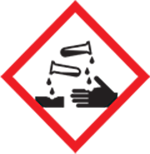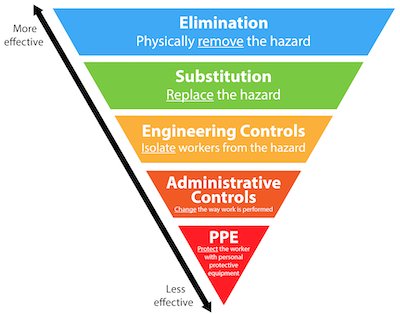Phosphorus Pentoxide
This chemical standard operating procedure (SOP) and the associated Safety Data Sheet (SDS) are for our safety. Read and understand both documents. If this is a paper copy, check for updated versions on the IsoLab website.
Process
Phosphorus pentoxide is used as part of our Making phosphoric acid SOP.
Hazards - SDS

Causes severe skin burns and eye damage. Reacts violently with water.
Protection - SDS

Engineering Controls
Use a fume hood when working with phosphorus pentoxide. Ensure the fume hood has proper air flow by checking the flow rate on the control panel and / or using a smoke match or wipe to visualize flow.
PHS - We use phosphorus pentoxide when making 100% phosphoric acid which can be a messy affair. In this case, the fume hood is convenient to keep everything contained for easier cleanup, not for protection against fumes.
Administrative Controls
PHS - Tape a sign to the outside of the fume hood sash indicating that you are making phosphoric acid. This process often takes more than one day.
Personal Protective Equipment (PPE)
PHS - Wear a lab coat, nitrile gloves, and eye protection.
Handling - SDS
Keep container tightly closed when not in use. Keep away from other sources of water but recognize that you are adding phosphorus pentoxide to 85% phosphoric acid (the other 15% is water) specifically to convert the solution water to phosphoric acid. As such, if you add it too quickly, the solution will steam and appear aggressive. If you spill powdered phosphorus pentoxide, it will quickly absorb water from the atmosphere leaving a puddle of phosphoric acid.
PHS - Decontamination - Clean all materials in the hood, and the hood itself with wet paper towels until all acid residue to removed.
Storage - SDS
Phosphorus pentoxide is stored in the corrosives cabinet under the fume hood in 302A. Use MyChem, the UW EH&S chemical inventory database, for more lab-suite specific storage details.
Spills - SDS
Avoid inhaling dust.
PHS - Exposure:
- Inhalation - Move person into fresh air. If not breathing, give artificial respiration. For advice, call UW Employee Health Center (206.685.1026) or the Washington Poison Center (800.222.1222). For emergency help, call 911.
- Skin contact - Take off contaminated clothing and shoes immediately. Wash off with soap and plenty of water. For advice, call UW Employee Health Center (206.685.1026) or the Washington Poison Center (800.222.1222). For emergency help, call 911.
- Eye contact - Rinse thoroughly with plenty of water for at least 15 minutes. Continue rinsing eyes during transport to hospital. For advice, call UW Employee Health Center (206.685.1026) or the Washington Poison Center (800.222.1222). For emergency help, call 911.
Inside Fume Hood Spill - If the spill is fully contained inside the fume hood, close the sash and prepare yourself to clean it up. If needed, grab the closest spill kit. Make sure you have donned all the above-described appropriate PPE. Do not allow the substance to enter the drain. Put all generated waste into a bag. See Waste section below.
Outside Fume Hood Spill - Avoid breathing dust. Don a respirator as needed; respirators are in drawers on the west wall of 303B. Grab the closest spill kit. Make sure you have donned a lab coat, nitrile gloves, and eye protection. Consider using goggles (also in 303B west wall drawers). Do not allow the substance to enter the drain. Put all generated waste into a bag. See Waste section below.
If you need assistance or advice, use the IsoLab Emergency Contacts sheet.
Consult the EH&S Spill Poster and Exposure Poster
Waste - SDS
If you are cleaning up after a spill and have a bag of debris, ensure the bag is sealed and use multiple bags as needed. Complete an EH&S Hazardous Waste Label and adhere it to the bag. Here are instructions for how to label chemical waste containers. Labels are located in a drawer on the west wall of 303B near the door to the hallway.
Put all waste, solid or liquid, into a wide-mouth plastic container. Options for waste containers can be found under the west sink in 303B. Complete an EH&S Hazardous Waste Label and adhere it to the bottle. Here are instructions for how to label chemical waste containers. Labels are located in a drawer on the west wall of 303B near the door to the hallway.
Place the properly labeled container in one of the gray tubs near the hallway door of 303B. Segregate from other waste containers as appropriate.
Consult our generalized Chemical Waste Disposal SOP.

Training - PHS
Phosphorus pentoxide is deemed a particularly hazardous substance - PHS by EH&S and you need approval before using it. Complete the list of requirements below before using this chemical.
Prerequisites
- You must have completed Managing Laboratory Chemicals in the last three years. Login to check.
- Read and understand the SDS for Phosphorus pentoxide.
- Read, understand, and digitally sign this SOP.
- Contact your Principal Investigator (PI) AND the Chemical Hygiene Officer (CHO) indicating that you have completed all prerequisites and await approval.
